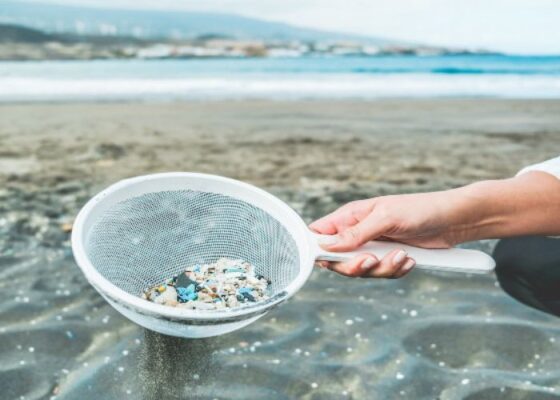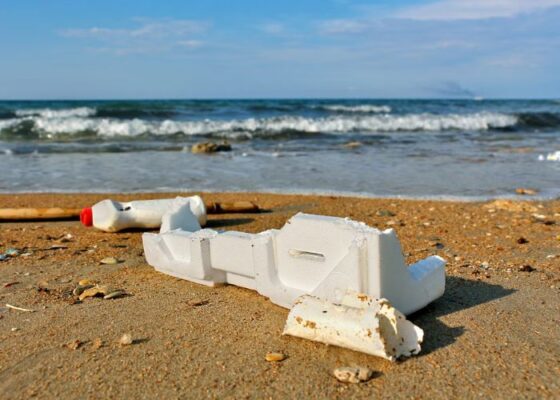As I walk along the pristine sands of Playa Conchal in Costa Rica, the early morning light glints off seashell fragments strewn across the beach. At first glance, they look like the natural debris left by the tide. But on closer inspection, I realize with a sinking heart that many are not seashells at all, but tiny shards of plastic. Read below about “Costa Rica Paradise Under Threat- How Microplastics Are Destroying Its Beaches”.
This is not the first time I’ve seen microplastics on Costa Rica’s famous beaches. Over my last 7 years visiting this eco-paradise, I’ve watched in dismay as these tiny plastic particles have slowly multiplied on shoreline after shoreline.
And I’m not the only one noticing the creeping plastic plague. Scientists have been quantifying the accumulation of microplastics on Costa Rica’s beaches since 2009. What they’ve found is shocking.
Table of Contents
The Rising Tide of Microplastics
Pristine coastlines and lush rainforests have made Costa Rica one of the world’s most iconic eco-tourism destinations. Its beaches attract over 3 million visitors per year. But this paradise is under threat from a tide of microplastics that are despoiling its iconic shores.
In 2009, researchers already found an average of 40 microplastic particles per square meter on four beaches around Manuel Antonio National Park. Just seven years later, a 2016 study discovered an average of 102 particles per square meter on beaches around the Gulf of Nicoya. That’s a 255% increase in less than a decade.
The most recent study in 2020 found an average of 170 particles per square meter accumulated on beaches around the Osa Peninsula. That’s a 325% increase over 2009 levels.
And remote beaches are not immune. A 2022 survey of Playa Norte on uninhabited Isla del Coco found an average of 68 particles per square meter had washed up on its isolated shores.
As someone who has visited Costa Rican beaches annually for the past 7 years, I have watched this mounting tide of microplastics with my own eyes. Where once I spotted the occasional plastic fragment, now I frequently find plastic bits outnumbering seashells in some areas. Costa Rica’s microplastic problem has grown exponentially over the last decade – and is showing no signs of stopping.
Why Care About Microplastics?

So why does a few tiny plastic bits matter? Aren’t beaches dirty anyway? Microplastics may be small, but they have an oversized impact.
There are two main reasons we should all be concerned about plastic pollution in paradise:
- It harms marine ecosystems
- It puts human health at risk
While a plastic shard smaller than 5 mm may seem harmless, it causes significant ecological damage. Seabirds, fish, and other marine animals easily mistake these tiny plastic bits for food. But they can block digestive tracts, damage organs, or leach toxic chemicals into animals’ tissues when eaten.
Microplastics also absorb and concentrate waterborne pollutants like pesticides and heavy metals. When accidentally ingested, these toxins then transfer into the bodies of animals, bioaccumulating up the food chain. So by the time we eat contaminated seafood, we may be unknowingly exposing ourselves to some severe health risks.
The buildup of microplastics in Costa Rica thus threatens both its precious ecosystems and booming tourism economy. As an eco-conscious traveler who has returned to Costa Rica’s beaches year after year, I have been increasingly alarmed to witness the scale of plastic pollution firsthand.
Where Do All These Microplastics Come From?
To tackle Costa Rica’s microplastic problem, we first need to understand where all this plastic debris comes from.
Researchers have identified three main sources:
- Microfibers from synthetic clothing
- Fragmented plastic waste
- Microbeads from cosmetics
Microfibers are tiny plastic threads that detach from synthetic fabrics like polyester during washing. These minute fibers then travel through wastewater into rivers, lakes, and oceans. Studies have found a single garment can shed over 1,900 microfibers per wash!
Plastic waste like bags, bottles, ropes, and nets also slowly fragment into microplastics under solar radiation and wave action. These tiny secondary microplastics then accumulate in staggering numbers on shorelines.
Finally, microbeads are tiny plastic particles manufactured into products like face washes and toothpaste for exfoliating purposes. Although Costa Rica banned microbeads in cosmetics in 2017, some still inevitably reach waterways through wastewater contamination.
Solutions to the Plastic Pandemic
The key to tackling Costa Rica’s microplastic scourge is attacking it at its source. As tourists who value Costa Rica’s pristine landscapes, we can be part of the solution by:
- Reducing our plastic waste
- Making conscientious consumption choices
- Supporting sustainability initiatives
To lower plastic waste, we can refuse single-use plastics, recycle all we can, and participate in beach cleanups. Choosing natural fabric clothing over synthetic wear can shrink our microfiber footprint. And buying products without microbeads avoids releasing more plastic into waterways.
As tourists, we can also patronize eco-lodges with sustainability certifications to support environmental best practices. On recent trips, I’ve stayed at hotels like Punta Islita and Pacuare Lodge that are pioneering plastic reduction through water refill stations and eco-friendly policies.
Finally, we can donate to nonprofits conducting critical conservation work across Costa Rica. Groups like Misión Tiburón are educating communities about threats from plastic pollution and sustainable solutions. And MarViva is campaigning for expanded marine protected areas to help fragile ecosystems recover.
Paradise Needs Protecting
The swelling tide of microplastics despoiling Costa Rica’s idyllic beaches offers a sobering reminder of plastic pollution’s far-reaching impacts. But it also presents an urgent call to action for tourists who care about protecting this eco-paradise for future generations.
By becoming conscious consumers, following best sustainability practices, and supporting environmental initiatives, we can help stem the rising plastic tide threatening Costa Rica’s exceptional natural heritage.
Over 7 years of visiting Costa Rica’s beautiful beaches, I have been distraught to watch plastic on these iconic shores slowly increase year after year. But I still have hope we can reduce this plastic pandemic by tackling the problem at its root. I hope you like reading “Costa Rica Paradise Under Threat- How Microplastics Are Destroying Its Beaches”.
With conscientious action from tourists and businesses alike, we can still preserve Costa Rica’s pristine wild places for the wildlife and adventurers who need them. But we need to act now before paradise slips through our fingers.
Michaela Krajanova is an expert in travel journalism and blogging. With over 10 years of experience and a Master’s degree in Hospitality Management, Michaela Krajanova has cultivated a substantial following on Instagram, showcasing her travel photography and insights. Explore engaging travel guides and stories on her Instagram handle @michaela_krajanova, where she connects with a vibrant community of travel enthusiasts. Michaela’s work makes travel accessible and inspiring for readers around the globe, providing firsthand experiences and expert advice.





